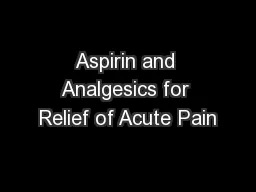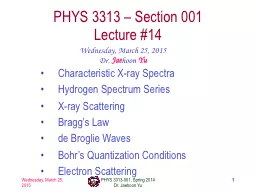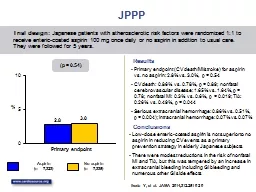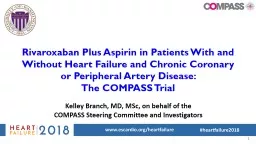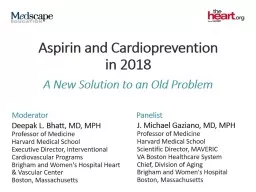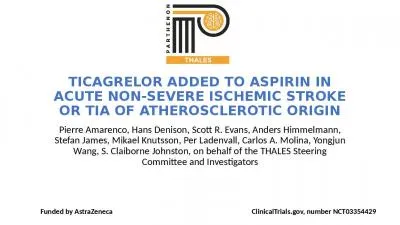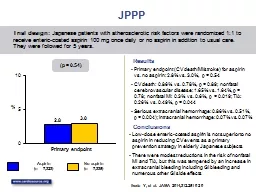PPT-Lesson 3: Aspirin D2 Wednesday, March 8
Author : stefany-barnette | Published Date : 2018-03-16
Understandings Aspirin Mild analgesics function by intercepting the pain stimulus at the source often by interfering with the production of substances that cause
Presentation Embed Code
Download Presentation
Download Presentation The PPT/PDF document "Lesson 3: Aspirin D2 Wednesday, March 8" is the property of its rightful owner. Permission is granted to download and print the materials on this website for personal, non-commercial use only, and to display it on your personal computer provided you do not modify the materials and that you retain all copyright notices contained in the materials. By downloading content from our website, you accept the terms of this agreement.
Lesson 3: Aspirin D2 Wednesday, March 8: Transcript
Understandings Aspirin Mild analgesics function by intercepting the pain stimulus at the source often by interfering with the production of substances that cause pain swelling or fever Aspirin . د. حسين محمد جمعة . اختصاصي الامراض الباطنة . . البورد العربي . كلية طب الموصل . . . . 2011. . . Dr. Day Wednesday March 7, 2012. Review: Exponent Properties (5.1). Logarithms (5.2). Converting exponent form to log form. Graphs of log functions. Using logs to solve equations. Wednesday, March 7, 2012. Coping with exam . stress. . Coping with Exam Stress-Monday and Wednesday lunchtime - Week 2- S4. All sessions are open to both YEAR 11 and YEAR 10- starting at 12.45- bring your lunch- . or . leave . Chapter 14. Aspirin. Pharmaceutical products are often developed from substance found in a plant that has been used for traditional medicine.. Aspirin is one of these products.. Salicylic acid is the active substance that helps . Evaluating the Risks and Benefits. Most Frequently Used OTC Analgesics. Reasons Why These Drugs Are Widely Used. What Limits the Use of OTC Drugs?. Adverse Effects of OTC Analgesics. Efficacy of Aspirin in Headache. PHYS 3313-001, Spring 2014 Dr. Jaehoon Yu. 1. PHYS. 3313 . – Section 001. Lecture . #14. Wednesday. ,. March 25, 2015. Dr. . Jae. hoon . Yu. Characteristic . X-ray . Spectra. No aspirin (n = 7,335) JPPP Primary endpoint (CV death/MI/stroke) for aspirin vs. no aspirin: 2.8% vs. 3.0%, p = 0.54 CV death: 0.86 % vs. 0.78%, p = 0.89 ; nonfatal cerebrovascular disease: 1.65 Rivaroxaban Plus Aspirin in Patients With and Without Heart Failure and Chronic Coronary or Peripheral Artery Disease: The COMPASS Trial Kelley Branch, MD, MSc, on behalf of the COMPASS Steering Committee and Investigators Primary Prevention ASCVD. Jennifer Bannon RN BSN MSHI. Table of Contents. Objectives . Cardiovascular Disease. Cardiovascular Disease (2). ABCS-Aspirin when appropriate. Anatomy of a Performance Measure. in 2018. 3 Settings for Initiating Aspirin. Serious Vascular Events in Primary Prevention Trials. USPSTF Analysis. USPSTF 2016 Statement of Aspirin Use. Contemporary Clinical Trials Exploring the Role of Aspirin for Cardioprevention. as salicylic acid and its derivatives e.g. aspirin, and . paracetamol. , . block the transmission of pain from source . i.e. the injured tissue to . brain as they intercept the pain stimulus . at source. . ORIGIN. Pierre . Amarenco. , Hans . Denison. , . Scott R. Evans, Anders . Himmelmann. , Stefan James, Mikael . Knutsson. , . Per . Ladenvall. , Carlos . A. Molina. , . Yongjun. Wang. , S. . Claiborne . Primary endpoint . (CV death/MI/stroke) for aspirin vs. no aspirin: . 2.8% vs. 3.0%, . p = 0.54 . CV . death: 0.86. % vs. 0.78%, . p = 0.89. ; nonfatal . cerebrovascular . disease: 1.65. % vs. 1.64%, . March 28, 2022. Disclosures. Present Research/Grant Funding. Janssen/Johnson & Johnson. CSL Behring. SCAD Alliance. Baim. Institute. Patents and Stocks: . None. Equity: . nference. , Inc. . Dyad Medical.
Download Document
Here is the link to download the presentation.
"Lesson 3: Aspirin D2 Wednesday, March 8"The content belongs to its owner. You may download and print it for personal use, without modification, and keep all copyright notices. By downloading, you agree to these terms.
Related Documents





